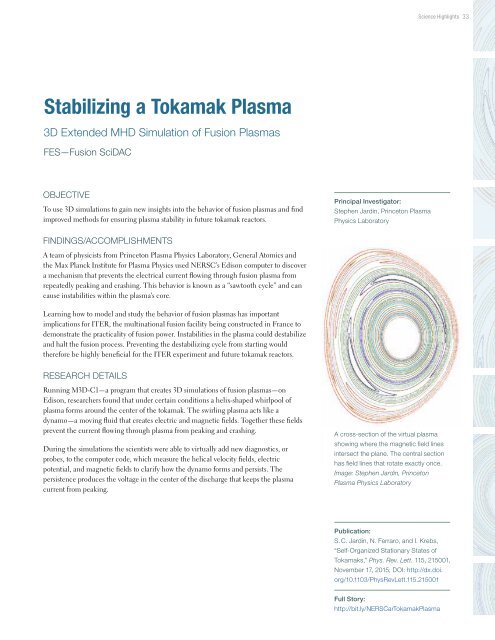National Energy Research Scientific Computing Center
BcOJ301XnTK
BcOJ301XnTK
You also want an ePaper? Increase the reach of your titles
YUMPU automatically turns print PDFs into web optimized ePapers that Google loves.
Science Highlights 33<br />
33<br />
Stabilizing a Tokamak Plasma<br />
3D Extended MHD Simulation of Fusion Plasmas<br />
FES—Fusion SciDAC<br />
OBJECTIVE<br />
To use 3D simulations to gain new insights into the behavior of fusion plasmas and find<br />
improved methods for ensuring plasma stability in future tokamak reactors.<br />
Principal Investigator:<br />
Stephen Jardin, Princeton Plasma<br />
Physics Laboratory<br />
FINDINGS/ACCOMPLISHMENTS<br />
A team of physicists from Princeton Plasma Physics Laboratory, General Atomics and<br />
the Max Planck Institute for Plasma Physics used NERSC’s Edison computer to discover<br />
a mechanism that prevents the electrical current flowing through fusion plasma from<br />
repeatedly peaking and crashing. This behavior is known as a “sawtooth cycle” and can<br />
cause instabilities within the plasma’s core.<br />
Learning how to model and study the behavior of fusion plasmas has important<br />
implications for ITER, the multinational fusion facility being constructed in France to<br />
demonstrate the practicality of fusion power. Instabilities in the plasma could destabilize<br />
and halt the fusion process. Preventing the destabilizing cycle from starting would<br />
therefore be highly beneficial for the ITER experiment and future tokamak reactors.<br />
RESEARCH DETAILS<br />
Running M3D-C1—a program that creates 3D simulations of fusion plasmas—on<br />
Edison, researchers found that under certain conditions a helix-shaped whirlpool of<br />
plasma forms around the center of the tokamak. The swirling plasma acts like a<br />
dynamo—a moving fluid that creates electric and magnetic fields. Together these fields<br />
prevent the current flowing through plasma from peaking and crashing.<br />
During the simulations the scientists were able to virtually add new diagnostics, or<br />
probes, to the computer code, which measure the helical velocity fields, electric<br />
potential, and magnetic fields to clarify how the dynamo forms and persists. The<br />
persistence produces the voltage in the center of the discharge that keeps the plasma<br />
current from peaking.<br />
A cross-section of the virtual plasma<br />
showing where the magnetic field lines<br />
intersect the plane. The central section<br />
has field lines that rotate exactly once.<br />
Image: Stephen Jardin, Princeton<br />
Plasma Physics Laboratory<br />
Publication:<br />
S. C. Jardin, N. Ferraro, and I. Krebs,<br />
“Self-Organized Stationary States of<br />
Tokamaks,” Phys. Rev. Lett. 115, 215001,<br />
November 17, 2015; DOI: http://dx.doi.<br />
org/10.1103/PhysRevLett.115.215001<br />
Full Story:<br />
http://bit.ly/NERSCarTokamakPlasma


